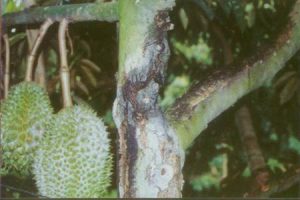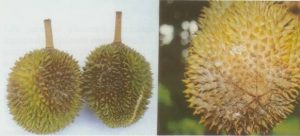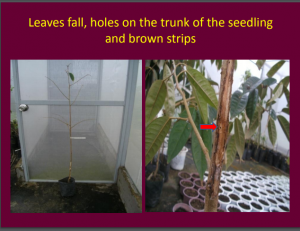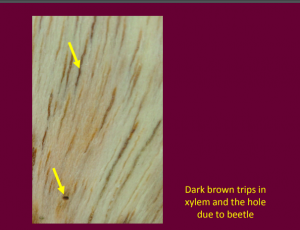METHOD TO MANAGE PHYTOPHTHORA DISEASE OF DURIAN
Phytophthora palmivora (Butler) has been considered one of the most destructive organisms causing several diseases in almost all growth stages of durian (Fig. 1(0) & Fig. 2(0)). The disease symptoms come in various forms such as root rot, seedling and tree die-back, patch canker or stem rot, and fruit rot before and after harvest, leading to high mortality and more than 30% yield loss in durian plantations.


Researchers from the University of Southern Mindanao (USM), Philippines, conducted a technology search in Malaysia and Thailand and documented the following technologies to overcome the destructive effects of Phytophthora in durian:
Pre-Planting and Planting Techniques
-
Constructing a drainage system. In Thailand, durian trees are planted in raised beds on flat to semi-flat lands to allow the base of the plants to dry after a heavy rain. This makes the tree more responsive to dry stress, a prerequisite to extensive watering to induce flowering and fruiting. A good drainage system also reduces uneven fruit ripening and incidence of wet core and other fruit disorders, and prevents the spread of disease.

-
Adjusting soil pH and applying organic matter (OM) prior to planting. Liming within 30 cm of the soil surface at a radius of 1 m, where majority of the roots are expected to develop, can raise the soil pH. A soil pH lower than 5.3 is highly conducive to Phytophthora organisms. Moreover, organic fertilizers, including animal waste (e.g. chicken dung), can be applied on soils with less than 2% OM.

-
Setting up irrigation facilities. In Thailand, almost 100% of durian farms are provided with good irrigation facilities before planting. Adequate water supply helps young durian plants become less susceptible to Phytophthora infection. Effect of water stress in durian includes premature dropping of leaves.
-
Using large planting material (LPM) resistant clones. Plants that are 1.5 m tall and above are more tolerant to environmental stress, so establishment can be rapid, resulting in faster growth and resistance to diseases. Clones from Malaysia (‘D2,’ ‘D10,’ ‘MDUR 79,’ and ‘MDUR 88’) and Thailand (‘Chanee’) are the best in terms of fruit quality, yield, and resistance to Phytophthora.
-
Providing adequate space for each plant. In Thailand, wider spacings of about 8 m x 8 m (for varieties with medium-sized canopy like ‘Monthong’) to 10 m x 10 m (for varieties with spreading canopy like ‘Arancillo’ and ‘D 24’) are effective for disease control and spread. With these spacings, overlapping of canopies is minimal, allowing good light and penetration. High-density planting creates humidity and reduces air movement, conditions that favor Phytophthora infection. In situations where durian is intercropped with other crops such as coconut and mangosteen, the leaves of the intercrops should not overlap with those of durian.
-
Planting durian in mounds. The plants are placed on top of the soil surface and not in dug holes, with pulverized soil added around the plants to form a mound. This ensures adequate drainage at the base of the plants, preventing raindrops from splashing wet bits of soil to the leaves, trunks, and stems of the plant. It can create an intermittent short, drier condition at the base of the plant, preventing disease infection.
-
Conducting orchard post-planting activities. It is important that durian trees be kept healthy by providing adequate fertilization, irrigation, pruning, and other good management practices that will make the trees strong and capable of overcoming infection. Moreover, the trees should not be allowed to produce fruits more than the plant could support.

